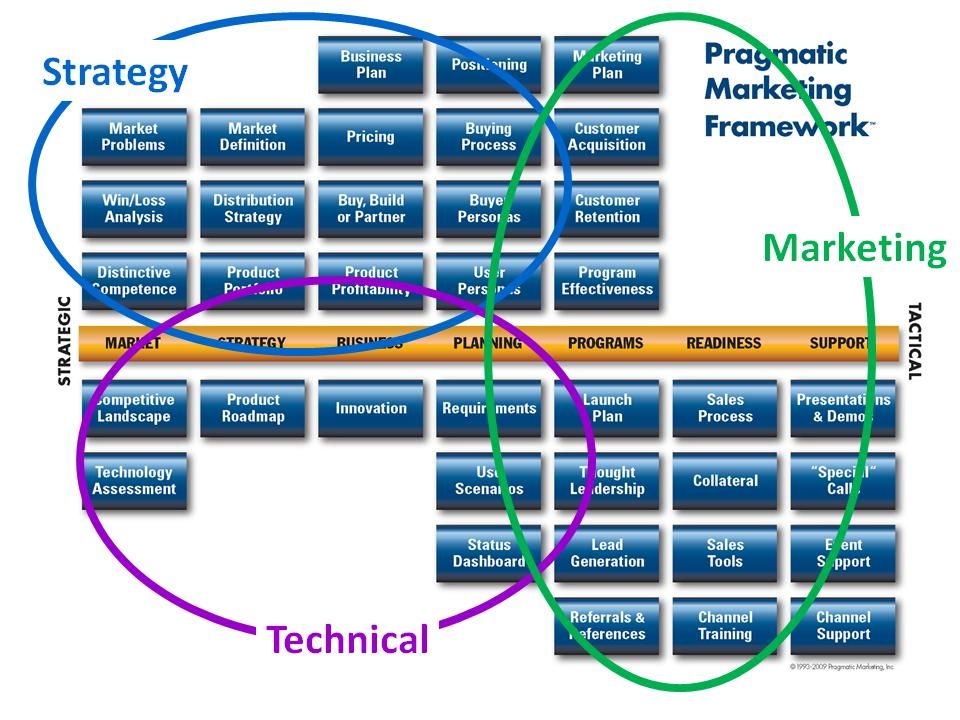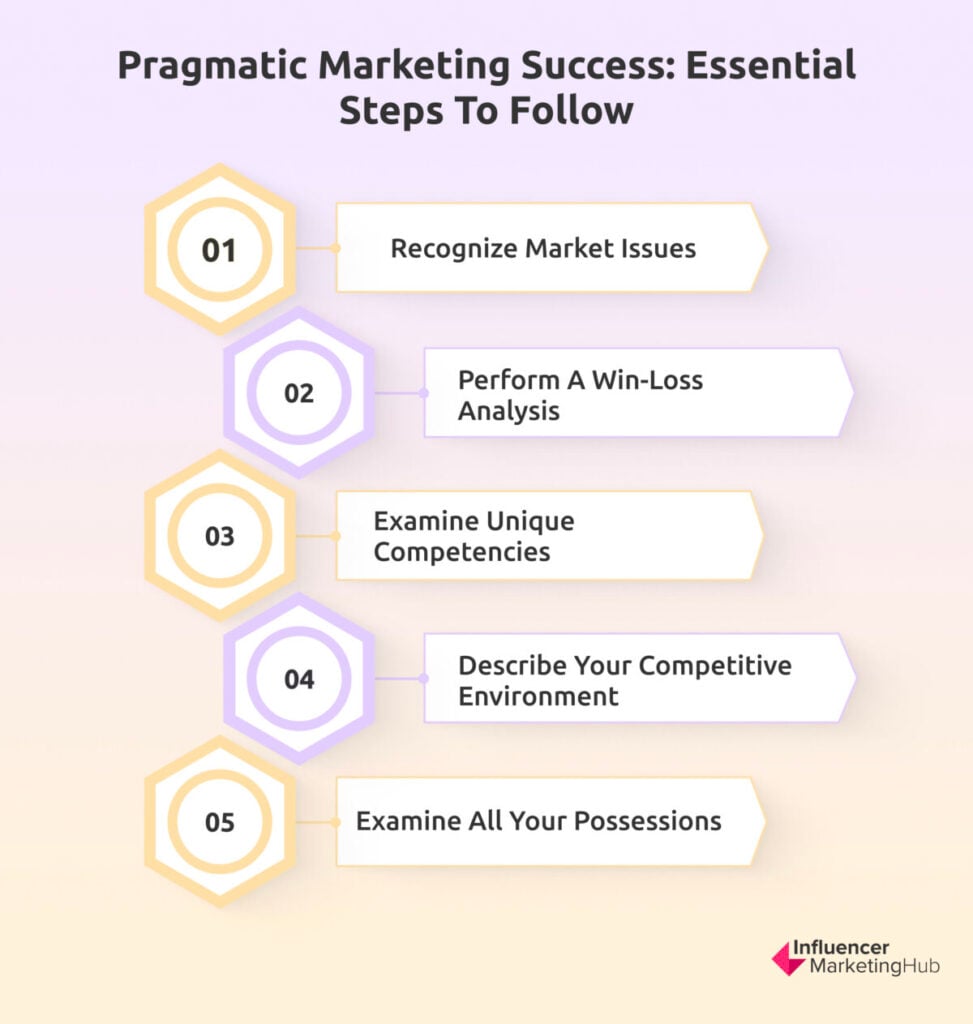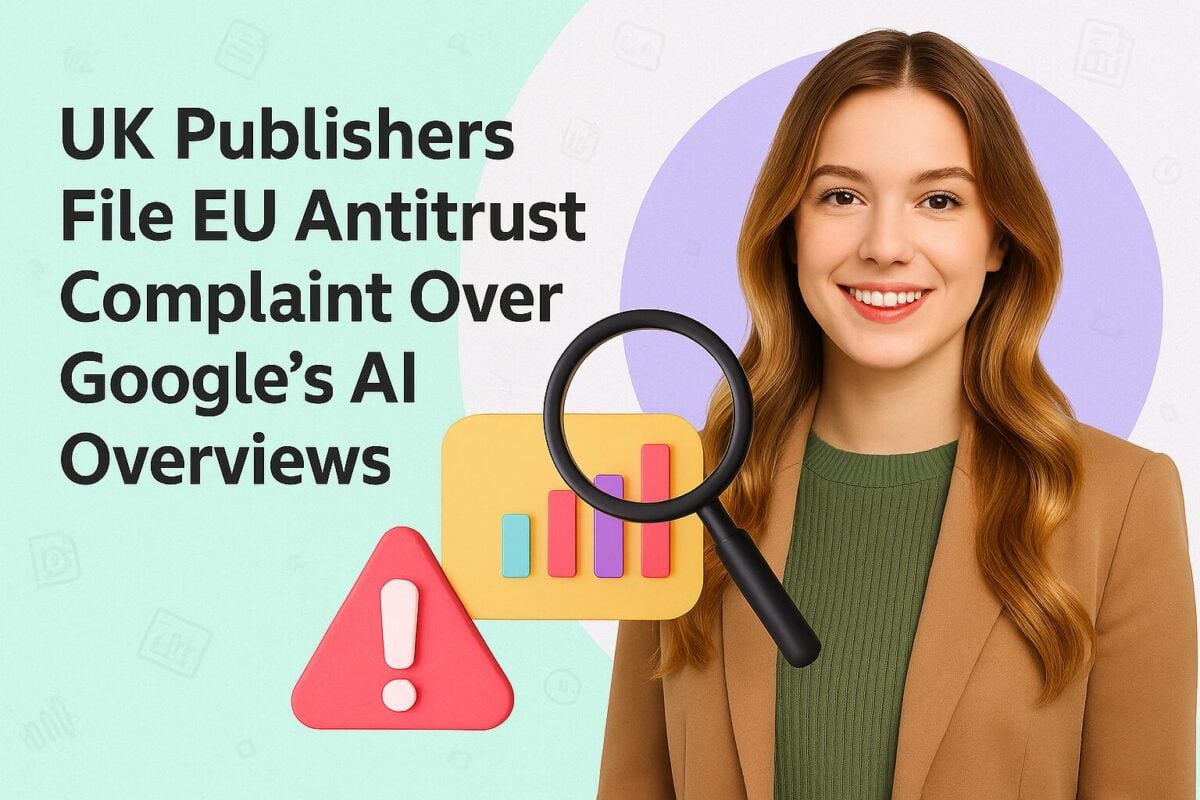Too often in the past, firms began with a product and then utilized marketing to sell that product to potential customers. Pragmatic marketing turns the traditional approach upside down because it begins with discovering customers’ needs and then creating products that will meet them.
For pragmatic marketing to work, you first need to go through a series of steps, including researching the needs of selected market segments, creating sample products, and then analyzing customer responses throughout a product life cycle.
- What is Pragmatic Marketing?
- Where Does the Idea of Pragmatic Marketing Originate From?
- Benefits of Using Pragmatic Marketing
- The Pragmatic Marketing Framework
- General Steps to Follow When Using the Pragmatic Marketing Framework
- The Product Management Triad
- Responsibilities of Your Product Management Triad
- How Does Pragmatic Marketing Compare to Agile Marketing?
- Wrapping Things Up
- Frequently Asked Questions
What is Pragmatic Marketing?
Pragmatic marketing is a customer-centric marketing framework that aims to deliver products as specified by your preferred customers. Firms use it to ensure that they deliver products that best match the customer’s needs.
Companies can follow through the steps of pragmatic marketing to design and launch products that their ideal customers need and want. Therefore, brands following the pragmatic marketing framework consider it a key part of the product development process. Despite its name, pragmatic marketing is more than just marketing, it incorporates the entire process of product design and selection.
Where Does the Idea of Pragmatic Marketing Originate From?
The ideas behind Pragmatic Marketing came from a self-titled educational organization, set up in 1993. In late 2018, Pragmatic Marketing (the organization), joined with The Data Incubator (TDI), a leading data science training organization, to become the Pragmatic Institute. Many of the ideas behind Pragmatic Marketing (the concept) are theirs, as is the Pragmatic Marketing Framework. The Pragmatic Institute now carries out training on many aspects of Product, Data, and Design – all of which are essential components of pragmatic marketing.
Benefits of Using Pragmatic Marketing
Pragmatic marketing gives your team a focus, helping ensure that they devote their time and resources to developing products that your preferred customers actually want. Another benefit of pragmatic marketing is that it ensures that your whole team uses consistent terminology and is on the same page. It also provides clear steps for your team to take yet offers all the necessary flexibility to make it work in vastly differing situations.
An essential part of pragmatic marketing is being prepared to make a series of product adaptations and tests to ensure that you make what your intended customer truly wants.
For example, you might want to create some form of self-improvement app for a particular type of consumer. Rather than building an app with a selection of features and benefits you think may be valuable, you would instead begin by working with members of your intended audience to discover what features would truly interest and benefit them. You would then make prototypes of your app, testing them each time with sample consumers, and then adapting the features included in your commercial release to reflect your testers’ feedback.
This gives you a chance to gradually refine your new product, meaning that it may appear more market-ready once it hits the marketplace. You will generally be able to feel positive about your product on launch day, as you won’t be gambling on whether consumers are likely to have an interest in your product.
In addition, because you will already have extensively tested and adapted your product before launch day, you are likely to increase its usefulness and life cycle. By pushing your energies and resources towards developing products that you know have a demand, you are less likely to spend resources developing products that the market considers useless.
Finally, by following the pragmatic marketing framework, you set a clear roadmap for the creation and introduction of your new product line. You establish a clear strategic overview, ensuring your entire team can align with the plan.
The Pragmatic Marketing Framework
With Pragmatic Marketing effectively being a discipline, it should come as no surprise that it is based on a framework. This outlines a formal approach to product development and marketing, defining common vocabulary and suggesting the necessary steps you should follow to undertake the practice.
However, unlike some frameworks, the Pragmatic Marketing Framework makes a point of allowing each user to adapt it to meet its customers’ needs – it is “pragmatic”, after all.

Source: pragmaticinstitute.com
As you can see from the above diagram, the Pragmatic Marketing Framework encompasses many aspects of strategy, marketing, and technical matters, and suggests ways to organize your product management, despite involving multiple people with varying skill sets.
Although the size of this diagram may make the process appear daunting, not all aspects will be necessary for every firm. However, the framework does suggest a series of steps that most firms will want to go through to determine the best approach for them.
General Steps to Follow When Using the Pragmatic Marketing Framework
In all cases, if you want your firm to engage in pragmatic marketing, you should at least go through the following steps, as proposed by LogRocket:
- Recognize market issues – speak with potential customers and conduct customer interviews to pinpoint market issues. Prioritize the most urgent problems.
- Perform a Win-Loss Analysis – why did recent customers choose to purchase your product (and why did people decide not to purchase your product)?
- Examine unique competencies – perform an overall analysis of your company’s strengths and weaknesses.
- Describe your competitive environment – examine your competitors, potential substitutes, and alternative products. What are your strengths and weaknesses, compared to your competitors?
- Examine all your possessions, i.e., your marketing assets – what marketing assets could you use to spread your message?
If you compare these steps with the Practical Marketing Framework shown above, you will notice that these essential steps primarily cover the boxes on the left-hand side (Strategic) of the framework. As you go further through the process, you refine your strategy more, cover technical issues, and then move more into practical marketing activities, becoming more tactical in your planning the further you move through the process.
MasterClass suggests an approach covering the full length of the framework:
- Identify market problems
- Create a prototype
- Test with a small group
- Analyze the results
- Refine the product
- Test anew
- Launch the product
The Product Management Triad
You will notice that the version of the Practical Marketing Framework we have depicted here splits the tasks into three general (but overlapping) categories: Strategy, Technical, and Marketing. Although this is not shown in all versions of the framework, it does give a good indication of how many firms organize their product management teams.
Most employees prefer one or two of these general areas of product development and specialize in honing their skills in their preferred areas. By determining the strengths of your employees, you can put together an all-encompassing team, knowing that every essential activity is covered by competent and willing participants.
The Pragmatic Institute suggests you start with a business-oriented senior product manager responsible for product strategy, making them a director of products or product line manager (PLM). You could then add a technology-oriented technical product manager (TPM) and a marketing-oriented product marketing manager (PMM). However, the Pragmatic Institute warns not to split these managers into separate teams (e.g., the TPM in Development and the PMM in Marketing Communications). Instead, if you want them to act as a team, you must structure them as a team, with both the TPM and PMM reporting to the PLM.
Responsibilities of Your Product Management Triad
If you follow the Product Management Triad approach to pragmatic marketing, you can easily split your leadership functions logically.
1. Responsibilities of the Product Line Manager (PLM)
- Discovering and validating market problems
- Seeking new market opportunities by leveraging the company’s distinctive competence
- Defining and sizing market segments
- Conducting win/loss analysis
- Determining the optimum distribution strategy
- Providing oversight of strategy, technical, and marketing aspects of all products in the portfolio
- Analyzing product profitability and sales success
- Creating and maintaining the business plan including pricing
- Determining buy/build/partner decisions
- Positioning the product for all markets and all buyer types
- Documenting the typical buying process
- Approving final marketing and go-to-market plans
2. Responsibilities of the Technical Product Manager (TPM)
- Conducting technology assessments
- Analyzing the competitive landscape
- Maintaining the product portfolio roadmap
- Monitoring and incorporating industry innovations
- Defining user personas for individual products
- Writing product requirements and use scenarios
- Maintaining a status dashboard for all portfolio products
3. Responsibilities of the Product Marketing Manager (PMM)
- Conducting technology assessments
- Analyzing the competitive landscape
- Maintaining the product portfolio roadmap
- Monitoring and incorporating industry innovations
- Defining user personas for individual products
- Writing product requirements and use scenarios
- Maintaining a status dashboard for all portfolio products
How Does Pragmatic Marketing Compare to Agile Marketing?
Greg Marta of AgileSherpas believes the following interrelated methodologies can be used together to focus your marketing team on the right priorities:
- Pragmatic Marketing - uses a scoring methodology to determine which projects are most important
- Pragmatic Roadmapping - helps teams sort through scored projects to create the ideal sequencing
- Agile Marketing - helps teams break their roadmap of prioritized initiatives into bite-sized chunks so progress happens quickly
However, he appears to take a narrower view of Pragmatic Marketing compared to the Pragmatic Institute, which clearly considers Pragmatic Marketing to be much more than mere scorekeeping.
Indeed, the Pragmatic Institute itself argues that marketing should go agile. They see agile marketing as being an iterative and experimental approach to marketing that values adaptability and responsiveness to change over long-term planning. They highlight the core values of agile marketing (none of which conflict majorly with those of pragmatic marketing):
- Responding to change over following a plan
- Rapid iterations over big-bang campaigns
- Testing and data over opinions
- Individuals and interactions over one-size-fits-all
- Collaboration over silos and hierarchy
- Many small experiments over a few large bets (this core value appears to be missing from the Pragmatic Marketing Institute’s list, but is just as relevant to pragmatic marketing as it is to agile marketing)
Marketers who practice agile marketing put the customer experience at the center of everything they do, focusing on solving buyer problems and the buyer’s journey, not on selling and the sales cycle. This is very similar to the core of pragmatic marketing.
However, LogRocket observes that agile methodologies can fall flat if an organization can’t decide what needs to be built.
“Agile approaches to product management enable teams to deliver products more quickly, but they may not always be things that customers want to buy… Agile values and concepts are important in contributing to the success of the firm, which is why pragmatic marketing uses agile marketing techniques. With recommendations for what needs to be done, pragmatic marketing addresses the areas where agile methodologies are failing the business.”
Wrapping Things Up
Pragmatic marketing is never about pitching existing products to consumers. It starts much earlier in the process – discovering the products that the consumers want to buy. If you dogmatically wish to sell a “tried and true” product, then pragmatic marketing isn’t for you.
However, if you’re willing to upend your entire production line to ensure that you are delivering what consumers really want, then pragmatic marketing can provide the perfect process to achieve your goals.
That doesn’t mean that you stop pragmatic marketing once you’re ready to launch your product, however. This is the time to gather information from your early customers so you can enhance and improve your product for the next version. You then repeat this process continually, making fundamental shifts whenever your customer base suggests it's time to take a new approach.
Apple is a master of pragmatic marketing. Many firms would have stopped developing the iPhone once they had released the first version. How that isn’t how Apple operates. As soon as it released its first iPhone it was already carrying out customer research, discovering what it would take for its customers to ditch their new purchase and update to a better, brighter version. Apple has continued this process ever since. Along the way it discovered that its customers would be interested in both a bigger screen (birthing the iPad range) and a smaller screen (leading to Apple Watches). Apple follows a philosophy of “wrapping great ideas inside great ideas.”
Frequently Asked Questions
What is Pragmatic Marketing?
Pragmatic Marketing is a customer-centric framework designed to help organizations develop and market products that meet the actual needs of their target audience. Unlike traditional marketing approaches that start with a product, Pragmatic Marketing emphasizes understanding customer needs first and then creating products that fulfill those needs.
What are the key benefits of using the Pragmatic Marketing framework?
The benefits of implementing the Pragmatic Marketing framework include improved alignment between product development and customer needs, enhanced team efficiency, and a structured approach to product management. It also fosters better communication within teams by providing a common language and clear steps for product development and marketing.
How does Pragmatic Marketing differ from Agile Marketing?
While both Pragmatic Marketing and Agile Marketing focus on customer needs, Pragmatic Marketing is primarily a product management framework that emphasizes understanding market demands before product development. In contrast, Agile Marketing is more about adapting marketing strategies quickly in response to changing market conditions and customer feedback during ongoing campaigns.



